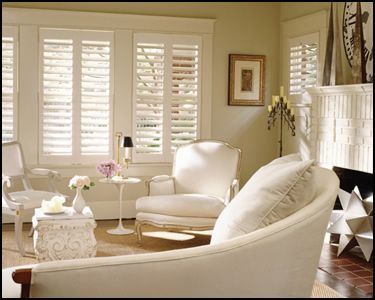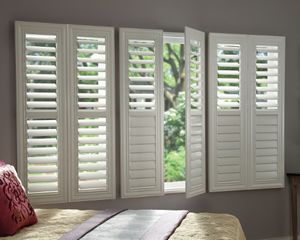Plantation Shutters

Plantation Shutters
Louver Sizes
2 ½” louvers for plantation shutters was the choice for many consumers in the late 1980’s and early 1990’s. Viewed as a traditional plantation shutter, it created a quality, finished window treatment.
The desire for cleaner looks had lead to the 3 ½”  louver plantation shutter dominating the market. Nearly 98% of all new shutter orders have the 3 ½” louver specified. Fewer louvers are necessary to build the shutter panel. When closed, they afford the same privacy as the 2 ½” louver. When opened however, the additional space between the louvers creates a dramatic, clean look that affords a greater view while still being subtle on your window.
louver plantation shutter dominating the market. Nearly 98% of all new shutter orders have the 3 ½” louver specified. Fewer louvers are necessary to build the shutter panel. When closed, they afford the same privacy as the 2 ½” louver. When opened however, the additional space between the louvers creates a dramatic, clean look that affords a greater view while still being subtle on your window.
Increasing in popularity is the 4 1/2″ louver. New construction today is outfitting homeowners with vinyl windows which provide a very deep window casement. This allows this large louver to sit flush inside of the molding and trim and allow for a true statement to be made!. As trends have shifted over the past 5 years, combining the 4 1/2″ louver with Superview has become an ever popular combination. Superview removes the traditional tilt rod from the front of the shutter panel and places it on the inside, or behind the panel if you will. It is not centered on the back but off to the side. Now you have created the cleanest, most modern look available in plantation shutters today. A perfect fit for the farmhouse look that is so popular today!
Traditional shutters or 1” to 1 ½” louvers signify what plantation shutters looked like in the early days of window treatments. Extremely small louvers created the need for multiple panels in a window. These panels then either bi-folded or tri-folded in order to give the homeowner an opportunity to generate light in their home. Seldom ordered unless trying to replicate a “certain period of time”, the cost of traditional shutters could easily cost twice as much as the 2 ½” louver or 3 ½” shutters.
How to Control Your Louvers for Light and Privacy
All louver sizes create an equal amount of privacy when closed. However, each home is different as well as the needs of the consumer. Some residences have close proximity to neighbors and need more privacy. How can this be achieved without making the room totally dark?

Center Divider Rail
This feature is typically placed in the center of a shutter panel although it can be specified to be placed virtually anywhere. By replacing a louver with a solid section, this creates a break in the louvers, (not the panel!). Now louvers can be moved independently. Close the bottom louvers to get the privacy where it is needed most while still allowing light to come through the top louvers…easy! This look also creates additional “curb appeal”. While it is typically 3 ½” in height, it can be seen from the street as it covers the sash or locking area of most double hung windows. While it creates a true shutter look on most double hung windows, it is not readily used on doors or fixed windows that have no break. The introduction of the divider rail on these applications can be viewed as too busy especially from the outside.

Split Tilt Bar
Some consumers like the idea of moving plantation shutter louvers independently to create the combination of privacy and light but do not like the look a solid piece of wood in the center of their window. Solution? Simply ask for the tilt rod (the stick that actually moves the louvers) to be split! This satisfies the desire for a cleaner look but without sacrificing the functionality.

Hidden Tilt Bar
Want to make a contemporary statement with your plantation shutter? Ask for a hidden tilt rod! While the tilt rod does not actually disappear, it is hidden on the backside of the panel. This clean, modern look takes the traditional aspect of plantation shutters and puts a contemporary twist on it! When constructed, it is automatically split in the center.

Single Shutter Panels
Single shutter panels have a 36” wide maximum. On any window 31” wide or larger, a single panel placed on this opening creates a more contemporary style. Since the louvers stretch across the entire window, the look is cleaner because you do not create a vertical line in the center where 2 panels meet. On smaller windows; 27” and smaller, a single panel is more desirable because the window itself is smaller. Adding an additional vertical line with 2 panels will crowd the window and make it look busy.

Open Center Double Panels
Double shutter panels that open from the center are the most common configuration of all shutter openings. Typically, this layout is applied to windows that measure 27” wide up to 48”. Due to furniture, accessories, plants and other items being in the path of most shutters, consumers find that they rarely swing the panels open. The controlling of the light is the key feature.

Bi-Fold Double Shutter Panels
When a consumer is confident and committed to actually opening the shutter panels on a regular basis, the ability for both panels to swing in the same direction can be desirable. When fully opened, the panels will lay on top of each other exposing the window to its fullest extent.

Double Bi-Fold Double Shutter Panels
When windows exceed 48” and greater, often the best layout and design is to have 4 total shutter panels. (2) will bi-fold left, (2) will bi-fold to the right. This keeps panels within the maximum widths and affords the consumer a chance to open all panels without a hindrance of the panels sticking straight out into a room or fighting for space with a neighboring panel.
-
Consider the number of panels per window
Plantation shutters are made with quality, North American hardwoods like basswood and poplar materials. Because it is real wood, size limitations exist. A shutter panel by definition is typically built as a continuous section of wood with the louver selection made and the decision as to whether add a divider rail, split the tilt rod, or none of the above. This covers from the window sill to the top of the window.
-
Inside Mount or Outside Mount?
The first thing your Peachtree Blinds of Atlanta sales rep will discuss with you is whether you have a “tilt in” feature to your window. Tilt in windows either have dual locks on top of your windows or plastic strips on the side that when pushed in allow you to tilt in your window towards the living space of your home. Why do we care? The preferred look of window treatments is typically to have a true inside mount. This preserves the look of the upgraded molding that come with today’s new construction. The shutter typically sits on the window sill and does not hang off. The trade off is that this will typically eliminate the ability to tilt in the window. As a consumer, you need to ask yourself the question… do I really clean my own windows? Do I have fixed windows that would force me to be outside of my house anyway? Whatever your answer, Peachtree Blinds can measure and produce a plantation shutter to satisfy your preference.
-
Unusual shapes and sizes
Arches, angles, doors with push lever handles, skylights…how does a consumer handle these issues? No problem! Since plantation shutters are built from real wood components, arch top windows, doors with cutouts can all be manufactured to work with your windows and doors. Bi-Pass plantation shutter tracks and bi-pass plantation shutter tracks are an ideal way to cover large spans of windows or sliding glass doors. Shutters are actually attached to a decorative header piece and travel on wheels providing maximum flexibility without stressing hinges or frames.
-
Colors
Plantation shutters can be custom paint matched to any color you choose. While we carry over 20 standard paint colors to keep in touch with the current designer paint schemes, by supplying either the code or an actual sample of your paint, Peachtree will scan the sample and create a sample to send for your approval.
Stained plantation shutters can add warmth to any room in your home. Peachtree carries over 13 standard stain colors originating from the Minwax color deck. Stain usually carries a surcharge and can add 2 weeks to production time as it is truly applied by hand!
-
Plantation Shutter Installation and Delivery
Installation will be provided by a full-time, highly trained installer. We do not use day labor or independent contractors. Whether it is Josh, Tommy, Mike or Caleb, their goal will be to provide a “white glove caliber” installation leaving your home in the same condition as when he arrived, only with more beautiful windows. Read our reviews on Google and Facebook to see what your neighbors are saying about our team! Delivery time for painted shutters is 4 to 6 weeks while stain & arches add 2 additional weeks.